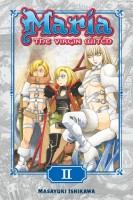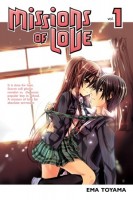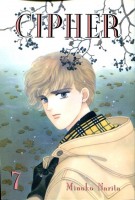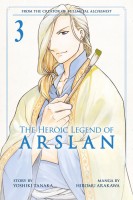My News and Reviews
Happy June, everyone! I’ve been super busy (I seem to say that a lot, don’t I?) but was still able to post a few things here at Experiments in Manga last week. The winner of the Ema Toyama Twosome manga giveaway was announced. That post also includes a list of manga available in English that feature novelists and other writers. The honor of the first in-depth manga review for the month of June goes to Masayuki Ishikawa’s Maria the Virgin Witch, Volume 2. Ishikawa seems to be trying to do a lot with such a short series (it’s only three volumes), maybe a bit too much. Even if he’s not able to successfully pull everything off, I still find Maria the Virgin Witch to be an intriguing series and want to read the rest of it. Finally, over the weekend I posted the Bookshelf Overload for May. I had a pretty big haul of manga and comics last month; I largely blame TCAF.
Elsewhere online there’s been some interesting reading to be found. Justin interviewed Kate Dacey (aka The Manga Critic) over at Organization Anti-Social Geniuses. Kate was one of my biggest manga blogging inspirations, so I’ve been very happy to see her recent return. Sean Kleefeld brought my attention to a panel on the history of manhwa. Drawn & Quarterly recently released the massive anthology Drawn and Quarterly: Twenty-Five Years of Contemporary Cartooning, Comics, and Graphic Novels. Joe McCulloch specifically looks at the volume’s manga content. Mangabrog has a translation of a conversation between Naoki Urasawa and Hisashi Eguchi. Last but not least, two licensing announcements were made last week that I’m very excited about: Viz Media is finally releasing a print edition of One-Punch Man by ONE and Yusuke Murata and Drawn & Quarterly is releasing more of Shigeru Mizuki’s GeGeGe no Kitaro! (I loved the publisher’s first Kitaro collection.)
Quick Takes
 Welcome to the N.H.K., Volumes 1-4 by Kendi Oiwa. Originally published in print by Tokyopop, Viz Media recently announced that it would be releasing Welcome to the N.H.K. digitally in the very near future. Tatsuhiko Takimoto’s original Welcome to the N.H.K. light novel was fantastic and I thoroughly enjoyed the anime adaptation, too. It was only a matter of time before I read Kendi Oiwa’s manga adaptation, though I am a little surprised that it’s taken me this long to get around to it. It has been a while since I’ve read or watched the other versions of Welcome to the N.H.K., but so far the manga is closer to the anime than it is to the novel, except that it seems a little more streamlined and perhaps even a little raunchier. Satou is a college dropout and hikikomori who has been targeted by Misaki, a young woman who is determined to rehabilitate him despite her own oddities and personal issues. In some ways, the more recent Watamote is reminiscent of Welcome to the N.H.K. Both series feature protagonists who are extremely socially awkward and both series can be hilarious, but they can also be somewhat depressing and painful to read at times, too. But, I am enjoying the manga version of Welcome to the N.H.K. a great deal.
Welcome to the N.H.K., Volumes 1-4 by Kendi Oiwa. Originally published in print by Tokyopop, Viz Media recently announced that it would be releasing Welcome to the N.H.K. digitally in the very near future. Tatsuhiko Takimoto’s original Welcome to the N.H.K. light novel was fantastic and I thoroughly enjoyed the anime adaptation, too. It was only a matter of time before I read Kendi Oiwa’s manga adaptation, though I am a little surprised that it’s taken me this long to get around to it. It has been a while since I’ve read or watched the other versions of Welcome to the N.H.K., but so far the manga is closer to the anime than it is to the novel, except that it seems a little more streamlined and perhaps even a little raunchier. Satou is a college dropout and hikikomori who has been targeted by Misaki, a young woman who is determined to rehabilitate him despite her own oddities and personal issues. In some ways, the more recent Watamote is reminiscent of Welcome to the N.H.K. Both series feature protagonists who are extremely socially awkward and both series can be hilarious, but they can also be somewhat depressing and painful to read at times, too. But, I am enjoying the manga version of Welcome to the N.H.K. a great deal.
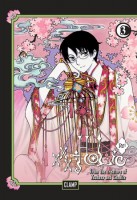 xxxHolic: Rei, Volume 3 by CLAMP. Initially, I felt that it wasn’t necessary to have read xxxHolic in order to enjoy xxxHolic: Rei. However after reading the third volume, I feel I need to revise that opinion. It’s still not absolutely necessary to have read xxxHolic, but Rei makes a lot more sense and is much more meaningful if a reader has that background. I’ve actually not finished reading the entirety of xxxHolic, so while I was able to get the basic gist of what was going on in Rei, I did feel I was missing out on some important context while reading the third volume. However, I really like what CLAMP is doing with the series and I’m looking forward to reading the part of xxxHolic where Rei ties in directly. Rei has developed a marvelously ominous atmosphere that has a surreal, dreamlike quality to it. CLAMP’s high-contrast artwork in the series is great, too. At first, Rei felt directionless as though CLAMP didn’t really know what to do with the series, but the third volume begins to bring everything together in a way that actually makes sense. Of course, this also means the Tsubasa: Reservoir Chronicles connection is becoming more pronounced as well, which can sometimes feel forced.
xxxHolic: Rei, Volume 3 by CLAMP. Initially, I felt that it wasn’t necessary to have read xxxHolic in order to enjoy xxxHolic: Rei. However after reading the third volume, I feel I need to revise that opinion. It’s still not absolutely necessary to have read xxxHolic, but Rei makes a lot more sense and is much more meaningful if a reader has that background. I’ve actually not finished reading the entirety of xxxHolic, so while I was able to get the basic gist of what was going on in Rei, I did feel I was missing out on some important context while reading the third volume. However, I really like what CLAMP is doing with the series and I’m looking forward to reading the part of xxxHolic where Rei ties in directly. Rei has developed a marvelously ominous atmosphere that has a surreal, dreamlike quality to it. CLAMP’s high-contrast artwork in the series is great, too. At first, Rei felt directionless as though CLAMP didn’t really know what to do with the series, but the third volume begins to bring everything together in a way that actually makes sense. Of course, this also means the Tsubasa: Reservoir Chronicles connection is becoming more pronounced as well, which can sometimes feel forced.
 Ze, Volumes 7-9 by Yuki Shimizu. Despite it being a series that I tend to enjoy, it’s actually been a few years since I’ve read any of Shimizu’s supernatural boys’ love manga Ze. Although there is some dubious content (which doesn’t really surprise me much at this point), these three volumes reminded me what it is about Ze that I like so much: Shimizu has a knack for creating fascinatingly intense and complex relationship and power dynamics. The seventh and eighth volumes explore the backstories of Kotoha and Konoe; I was very satisfied with the explanation of their peculiar relationship and personalities. (Granted, most of the characters and relationships in Ze are pretty strange.) Ze, Volume 8 focuses on Shoui and Asari. Most of the story arcs have been two volumes long, but perhaps because their relationship has been developing in the background over the course of the series, the eighth volume is the only one specifically devoted to the couple. These three volumes are also very important in setting up the next and what I believe is the final story arc which will reveal more of Waki’s tragic history. I had forgotten how much of an asshole he can be, so I am curious to find out what made him the person he is.
Ze, Volumes 7-9 by Yuki Shimizu. Despite it being a series that I tend to enjoy, it’s actually been a few years since I’ve read any of Shimizu’s supernatural boys’ love manga Ze. Although there is some dubious content (which doesn’t really surprise me much at this point), these three volumes reminded me what it is about Ze that I like so much: Shimizu has a knack for creating fascinatingly intense and complex relationship and power dynamics. The seventh and eighth volumes explore the backstories of Kotoha and Konoe; I was very satisfied with the explanation of their peculiar relationship and personalities. (Granted, most of the characters and relationships in Ze are pretty strange.) Ze, Volume 8 focuses on Shoui and Asari. Most of the story arcs have been two volumes long, but perhaps because their relationship has been developing in the background over the course of the series, the eighth volume is the only one specifically devoted to the couple. These three volumes are also very important in setting up the next and what I believe is the final story arc which will reveal more of Waki’s tragic history. I had forgotten how much of an asshole he can be, so I am curious to find out what made him the person he is.

